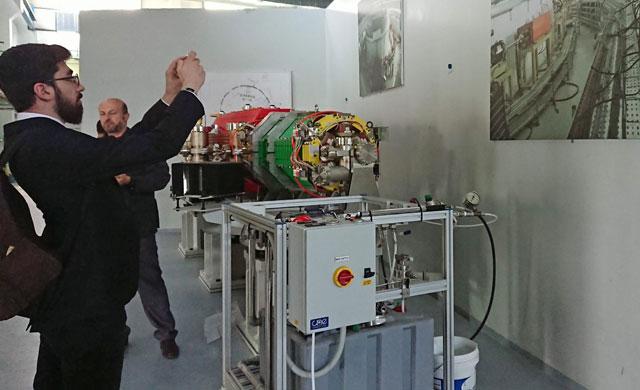You are here
Doubling in research proposals as SESAME gets increased attention
By Johanne Kalsaas - Nov 11,2018 - Last updated at Nov 11,2018

A delegation of security experts visits SESAME in Salt on Thursday (Photo courtesy of SESAME)
SALT — The International Centre for Synchrotron-Light for Experimental Science and Applications in the Middle East (SESAME) project on Thursday was praised by a delegation of Jordanian and foreign security practitioners as “an example of effective, innovative ways to overcome regional security issues”.
The delegation conducted the visit as they were participating in the Conference on Arms Control and Disarmament in the MENA region, organised by the Geneva Centre for Security Policy and Arab Institute for Security Studies.
Opened in May last year, the SESAME particle accelerator aims to promote a culture of peace through scientific cooperation across the region, among other goals.
“To my knowledge, this is the only organisation in the world having both Iran and Israel sitting at the same table”, said Scientific Director of SESAME Giorgio Paolucci. Other countries brought together by the first major international research centre in the Middle East include Egypt, Palestine, Turkey and Pakistan while a wide range of observer-states spanning from China to Canada are also supporting the Jordan-based flagship of global cooperation in science.
SESAME was modeled after the European Organisation for Nuclear Research, CERN, which was established in the wake of World War II to bring together adversaries and overcome a long history of animosity, in the name of science. This spirit of peaceful cooperation for mutual scientific and technological advancement is now gaining traction also in the Middle Eastern context, according to Paolucci.
“In our first call for research proposals in 2017, we received around 50 submissions from interested scientists. Preliminary data from the second round, which was only recently closed, shows that the numbers have almost doubled,” he said.
Much of this huge increase stems from growing awareness and interest in the synchrotron within the national scientific community as the number of research proposals from Jordan appears to have as much as quadrupled since the last round. In addition to Jordanians, scientists from across the Arab world as well as Europe and Asia have submitted proposals.
The growing interest in SESAME could be due to the planned expansion of beamlines. Today, the facility supports research employing XAFS/XRF (X-ray spectroscopy) and infrared spectromicroscopy. While this technology can be applied to a wide array of scientific research in biology, archaeology and medical sciences, Paolucci said the establishment of a new tomography beamline will make the synchrotron attractive to an even greater range of scientists. “This technology is unique in its versatility. It was chosen because it can be applied to so many different scientific fields,” he explained.
An Arab-European team of biologists and archeologists showed the delegation how they are using the synchotron to study cancer cells from local hospitals, excavated artifacts from Petra, soil types from Palestine and religious manuscripts from Iran, among other things.
Related Articles
AMMAN — After producing synchrotron light in the X-Ray Fluorescence beamline for the first time in the Arab and Islamic world, Jordan’
AMMAN — On December 17, SESAME opened the doors of its Materials Science (MS) beamline to a team from the Royal Scientific Society (RSS) in
AMMAN — The Synchrotron-light for Experimental Science and Applications in the Middle East (SESAME) on Monday announced that a group of its













